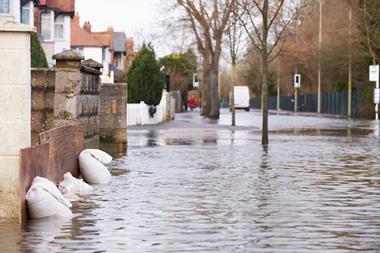Policyholders need to adopt flood resilience measures in the same way they would implement safety tools to protect against burglary, says Previsico’s chief executive
The insurtech sector has warned insurers that the Covid-19 pandemic could throw a spanner in the works when it comes to flood claims.
Jonathan Jackson, chief executive of Previsico, told Insurance Times that social distancing and other Covid-19 rules add “a new layer of complication and difficulty to claims responses”.
He said: “This could result in fewer people being available on the ground to help flood victims, both from insurers and from emergency services.”
Jackson highlighted that natural hazards, such as Storm Darcy and Storm Christoph earlier this year, pose “a severe risk of cascading disasters amid the backdrop of Covid-19”, putting pressure on emergency services and at-risk communities.
He additionally stressed that because “flood is already a bigger risk than home burglary, insurers need to start to change customer behaviour now by motivating or mandating customers to introduce flood resilience measures and sign up to flood warnings”.
However, flood data could help insurers plan ahead, he added.

Data in a hard market
Jackson continued: “In addition to the traditional risk maps, further evidence of resilience is being required by underwriters, like for more complex risks.
”Increasingly, small businesses are required to provide evidence of loss mitigation measures, flood action plans and the use of early warnings.
“Meanwhile, Flood Re’s Flood Performance Certificates are gaining traction across the industry, which will bring home that increased data becoming available will help proactive customers in a hardening market.”
Previsico worked with three underwriters in Lloyd’s Lab, the market’s insurtech base, and established that over 50% of homeowner losses could be prevented by using resilience measures and warnings, which Jackson deems “analogous to homes at high risk” of theft needing robust door and window locks, security systems and gates to help protect against burglary.
He said: “Flood risk at the householder level is significant, especially for surface water flooding, which the government states is the UK’s biggest flood risk. Therefore, homeowners must take responsibility by having flood resilience measures and act on flood warnings to do what they can to mitigate flood losses.
“Reducing property level flood risk will lead to a market where insurers feel able to offer flood protection to all households and will make Flood Re a true success story by closing, as planned, in 2039.”
Fast claims
Adam Rimmer, chief executive and founder of insurtech MGA FloodFlash, told Insurance Times that back-to-back storms are an issue for two reasons.
Firstly, if the ground is saturated from a previous event, it has less capacity to soak up excess water. That water then has to go somewhere else, causing a flood.
“Secondly, loss adjustment and recovery resources will be stretched,” Rimmer added. ”FloodFlash parametric claims don’t rely on loss adjustment, so they can be processed far quicker.”
FloodFlash paid a claim in nine hours and 44 minutes for Storm Christoph in January.
Rimmer continued: “Paying claims fast makes businesses survive. They can recover faster, which means they’re trading quickly and they’re not on their knees if a second flood happens in quick succession.
“In fact, we’ve paid all claims from Storm Christoph in full. That means that those customers have got access to recovery resources before they become scarce. It also means FloodFlash has no backlog, so we are ready to process any further claims arising from the upcoming disruption without delay.
“Melting snow, especially if it happens when the ground is frozen and the water can’t drain, can increase the probability of flooding and disruption to homes and businesses. The most severe UK flood of the last 100 years was in 1947 – and one reason that event was so bad was [because of] the amount of snow that had fallen beforehand.”
Jackson added: “Fortunately, in the UK, Storm Christoph’s impact was largely mitigated by river defences protecting an estimated 49,000 homes according to the Environment Agency.
“With [professional services firm PricewaterhouseCoopers] estimating total claims between £80m and £120m, the impact has been modest considering the UK’s history of severe winter floods.
”Yet, the risk remains high. It’s important for the industry to be more proactive in its approach to supporting customers to minimise the impact of future events during the pandemic.”
Hosted by comedian and actor Tom Allen, 34 Gold, 23 Silver and 22 Bronze awards were handed out across an amazing 34 categories recognising brilliance and innovation right across the breadth of UK general insurance.



















































No comments yet